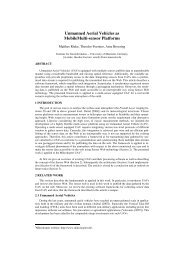A Conceptual Workflow For Automatically Assessing The ... - Agile
A Conceptual Workflow For Automatically Assessing The ... - Agile
A Conceptual Workflow For Automatically Assessing The ... - Agile
Create successful ePaper yourself
Turn your PDF publications into a flip-book with our unique Google optimized e-Paper software.
AGILE 2011, April 18-22: Frank O. Ostermann, Laura Spinsanti<br />
information from administrative or commercial datasets, e.g. land cover, population density, etc..<br />
<strong>The</strong> combination of these strands will give a measure of the overall quality/fitness-for-purpose of<br />
the VGI analyzed. <strong>The</strong> cross reference it is also useful to further assess a cluster’s credibility.<br />
This process is bidirectional: assess one piece of information can be used to define or modify the<br />
cluster assessment and vice versa.<br />
Spatio-temporal clustering<br />
a. After having assessed the quality of a single piece of information, it is necessary to look at the<br />
bigger picture and determine possible relationships between the various pieces of information.<br />
We argue that VGI can be used to validate data from other sources (e.g. remote sensing), or<br />
provide timely information on events that would otherwise remain undetected, or be detected too<br />
late: Events are time and space located so spatio-temporal clustering methods should be used to<br />
determine whether some information relates to the same forest fire event as other pieces of<br />
information. <strong>The</strong> clustering can be based on the data alone, or use background population<br />
information, such as the population density, for fine-tuning. First attempts will try to detect know<br />
fire events in the VGI data.<br />
Integration<br />
During the integration phase, the results of the processing phase are integrated with data from<br />
official, authoritative SDIs. <strong>The</strong> exact type and extent of integration depends on the target SDI: its<br />
complexity, granularity, and data formats, as well as its physical storage structure. Further, there are<br />
important legal consequences to be considered. <strong>For</strong> some public administrations, it may even be<br />
prohibitive to combine user generated content and their own data in a common structure. It is also<br />
expected that administrations will be reluctant to agree on a close or tight integration of VGI and<br />
official data because of liability issues. A loose integration that keeps the data separate but allows the<br />
combined use and display of VGI and SDI seems a more promising approach. In this case, the VGI<br />
needs to be converted and adapted to specificities of the target SDI.<br />
Dissemination<br />
During the dissemination phase, the results are reported to the two main target audiences of<br />
general public and decision makers. <strong>For</strong> both target audiences, making informed decisions under time<br />
pressure and uncertainty is a crucial requirement. However, the expected interfaces and circumstances<br />
of use can be expected to be very different. Public decision makers might rely on displays the size of<br />
desktop monitors, or even employ large wall-projected visualizations in a synchronous collaborative<br />
effort. <strong>The</strong>y can also be expected to have a sufficient level of domain knowledge to quickly assess<br />
implicit implications of the data presented. <strong>The</strong>ir aim is to coordinate efforts of crisis management.<br />
Public citizens, on the contrary, are much more likely to be mobile, employing devices with a small<br />
screen. <strong>The</strong>ir main objective is to find information on very concrete needs like evacuation routes and<br />
shelters. While they might have less detailed domain knowledge on disaster, they can be expected to<br />
have good locational knowledge. Both groups might also have very diverging requirements<br />
concerning the display of uncertainty inherent in the information. While decision-makers might want<br />
to deal with detailed information on different aspects of uncertainty (e.g. vagueness of locations) and<br />
need detailed levels of credibility and relevance, citizens might be overwhelmed by this information,<br />
and a simpler, binary classification such as “relevant/irrelevant” or “credible/dubious” might suffice.<br />
Clearly, these two target groups have very distinctive needs and requirements, which need to be<br />
addressed in a task- and user-driven design process of the visualizations.<br />
CONCLUSION<br />
In this paper, we have argued that VGI has immense potential in the use of managing crisis<br />
events. This utility is yet largely untapped. However, with the expected increase of VGI, the potential<br />
usefulness increases, while at the same time the problems in making the large volumes of relatively<br />
unstructured data also increase. Consequently, we have explored and presented a conceptual<br />
workflow for an automatized retrieval, processing, analysis, quality assessment and dissemination of<br />
user generated geographic content or volunteered geographic information (VGI). While the research<br />
aims to provide a complete coverage of a potential workflow, we focus on the geographic aspects of<br />
the data, i.e. the value of location information for determining the credibility and relevance of the<br />
VGI, and detection and assessment of crisis events. We have presented an approach that is modular<br />
and can easily incorporate research advances from other scientific disciplines, e.g. improved<br />
information retrieval procedures, semantic analysis methods, or new technological options for<br />
disseminating and visualizing the resulting quality-assessed VGI.<br />
4




